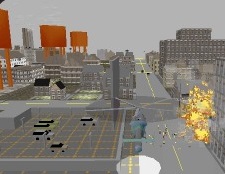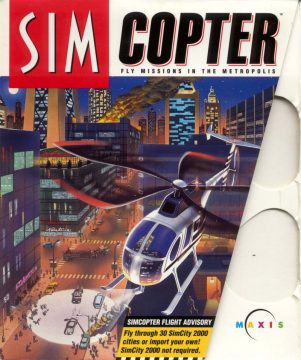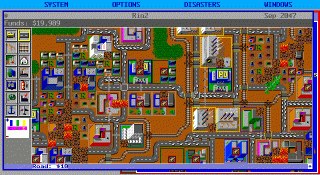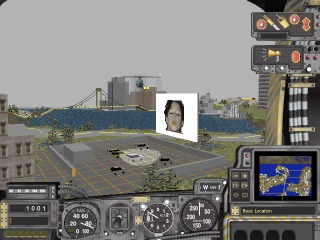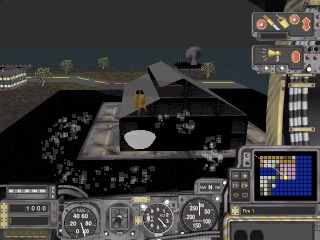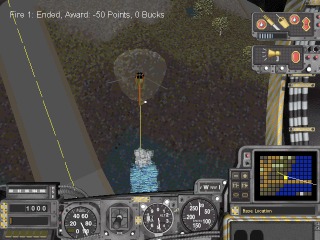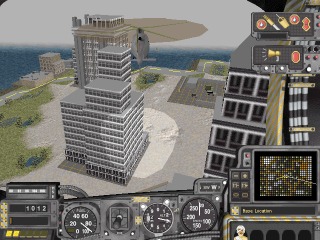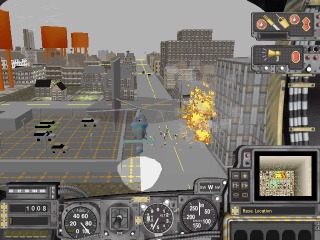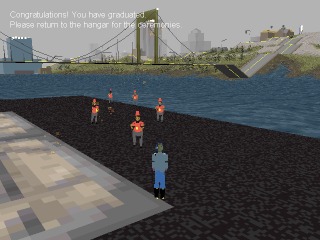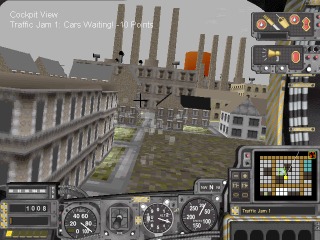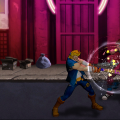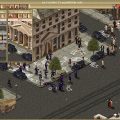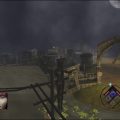The arresting power of the original SimCity in 1989 can seem alien to us today. The simulation is literally distant, hoisting the player heavenward and granting him the power to zone land for commercial, industrial, or residential development. An average play session is marked by mundane occurrences: traffic jams, natural disasters, budgets. For many, three decades on, the experience is haughty, removed, even a little dull. With context, we can better understand the delirious approval heaped on SimCity in its day.
Back in February 1989, a game with neither an objective nor protagonist was still a novelty. Bullfrog’s Populouswas several months away, and Myst wouldn’t turn exploration into an industry staple for another four years. Digital paint software and virtual engineering kits such as Electronic Arts’ Construction Set series had existed for some time, but these were borrowed capital – video game adaptations of art class and Erector sets.
SimCity was video gaming’s first indigenous species. Its tilt-shift world could exist only in computer space, powered by a million computing cycles per second. SimCity‘s creator, Will Wright, coined the term “software toy” to emphasize his innovation, and for years SimCity remained the most popular software toy on the market as players wrangled with the game’s open-ended questions.
What did the disembodied view represent? (A mayor’s daydreams over a topo map? A satellite feed? The eye of God?) And what did it mean to ‘win’ the game?
SimCity declined to dictate an end-game scenario. SimCity didn’t mind what you did. SimCity wasn’t prescriptive. It was your sandbox – an empty canvas, a blank check. The appeal lay in its subsystem-driven design, in which traffic, population, disasters, and utilities begin to interplay in surprising ways. The subsystems conceal an essentially simple simulation beneath layers of perceived complexity and allow players to improvise their own fun. No longer did the game designer, far removed by space and time, direct the experience with a firm hand. Instead the players called the shots, even to the extreme of wrecking their cities with a giant lizard or a tornado.
Players could come and go as they pleased, but in general they came (and stayed) in unprecedented numbers: a million units sold by 1992. It was a golden era for Will Wright and his comrades at Maxis Software, andSimCity‘s phenomenal performance gave the studio breathing room to tinker with the software toy. SimEarth, SimAnt, SimLife, and SimFarm marked the years following 1989’s gold boom, to varying degrees of success.
Through 1994, with the release of SimCity 2000, the Maxis monopoly on software toys continued. But the market was changing, and SimCity ‘s future hold on the rank and file looked tenuous. SimCity 2000 was gauche compared to 1995’s strategic heavy-hitters, Warcraft II and Command & Conquer. Elsewhere in the industry, Quake and hardware acceleration were about to rocket action gaming into the polygonal stratosphere.
As the SimCity 2000 revenue stream began to trail off, Will Wright cast about for something new, something different, something 3D. He alighted on a Hindenburg flight simulator. Though it would be shelved over concerns about Nazi imagery, the general flight sim concept would resurface soon enough.
1995 found Maxis in a state of turmoil with, as Geoff Keighly put it, “no focus, no clear direction, and Wall Street banging on the door.” An IPO had introduced capital, but mounting pressure came with the influx of cash. New management leveled an ultimatum on engineering: four products shipped by the end of 1996. Understaffed, out of time, and without a SimCity sequel in the pipeline, Will Wright dusted off the Hindenburg flight simulator and gave it a civic coat of paint. The game was to be the start of a new franchise and a prototype – a new moneymaker and Maxis’ polygonal debut.
Now it was Maxis’ turn to field hard questions. What was the SimCity philosophy in the context of a 3D action game? Could it survive the transition? Was there time to do it right?
SimCopter‘s box bears the elevator pitch: “Fly Missions in the Metropolis.” Flying. Missions. A metropolis.
The flying occurs in an assortment of real-life airframes from Bell, McDonnell Douglas, and Schweitzer. Handling and capacity vary according to real-world specifications, and better machines make it easier to complete missions. An algorithmic subsystem generates these missions along general categories: police work, medical evacuation, firefighting, riot control, and VIP transport. Completing missions pays cash to outfit your fleet and points to unlock new cities with higher difficulty.
Each metropolis is similar to the others – surreal, abstract, crude. Cars are flat-shaded jumbles of blocks that jerk along angular roads. People resemble the Intellivision Running Man with a magazine clipping for a face. Buildings are squat rectangles that fade in and out of the smog.
In addition to the thirty-odd cities on the disk, players can import their own SimCity 2000 creations and let the SimCopter engine extrude 2D data into 3D urban sprawl. Therein lies Will Wright’s two-part translation of the SimCity philosophy into the language of an energetic 3D action game.
From a traditional SimCity perspective, SimCopter adds value to a player’s existing investment. They can enjoy the fruit of their SimCity 2000 labor in a fresh way, with missions providing structure to the exploration of a beloved city. But as with SimCity, there’s no need to play by the rules. Central dispatch’s monotone voice will continue trying to pique your interest with an endless carousel of missions, but SimCopter‘s subsystems are at the player’s disposal.
The little marionette citizens dance and cluck their bizarre Simlish protests, the cartoon cars burst into flames at the touch of a landing skid, and the eerie expanse beyond the edge of the city limits beckons to the adventurous. One can play the distant observer, dutiful public servant, or Godzilla-esque natural disaster. And the bevy of cheat codes for free cash and helicopters – even an Apache gunship – tell the player to loosen up.
Alternately, from a 3D action viewpoint, SimCopter is a self-contained experience. The metropolis may not be yours if you don’t import from SimCity 2000, but SimCopter makes it easy to have fun in a strange land. It makes no mayoral demands. After all, zoning and infrastructure strategy isn’t relevant to the totalitarian glee of hosing down rioters with a water cannon.
There’s an immediate thrill to racing your helicopter under bridges in search of a hospital while a burn victim gurgles in the backseat. The difficulty curve is well-tuned, and the mission subsystem is varied. It’s true that SimCopter is less focused than what we’ve come to expect of action games, but it wore the mask well for its time.
And generally speaking, time has favored SimCopter. Huizinga would have us remember that seven Grand Theft Auto games have released since SimCopter hit shelves in February 1996. We have to think of SimCopter in an increasingly distant context, and as it matures into gaming history as a grandfather of the modern metropolitan sandbox genre, it grows more unique – empirically and subjectively.
Empirically, the 3D graphics industry has homogenized since 1996 and stranded SimCopter outside the pale of rendering convention. Fewer development houses write their own renderers. Unreal, CryEngine, and Unity all offer similar features based on the same academic research. SIGGRAPH attendance has declined since New Orleans ’96. These factors combine to give SimCopter a one-of-a-kind graphical style.
Subjectively, two decades have steeped SimCopter‘s depiction of city and citizenry into a heady mix. Your helicopter’s radio offers an eclectic, low-fi goulash of tunes. Commercials bookend the music with consumerist cynicism, deadpan puns and absurdities. Outside your helicopter, the hapless population communicates with “Simlish”, a piping, keening pidgin language. Simlish would make a famous repeat appearance in The Sims, but it’s more appropriate here in the alien world of SimCopter.
Fog shrouds the cities in slate grey by day and black at night. UFOs buzz high above the cityscape. The unflappable helicopter pilot flutters his legs and preens and coos as he hoists both people and dogs into the passenger bay. At the police station helipad, officers stagger and wave like so many badge-wearing zombies. If your rotors dice them to pieces during the landing attempt? Don’t sweat it, just run the medevac missions for bonus Simoleons.
It’s partly this eccentricity that has kept SimCopter alive in the collective gaming memory. Fan remakes for SimCopter get proposed frequently, and a spiritual successor mod for Cities: Skylines was underway at one point. While it’s natural to want to relive an enjoyable experience, does SimCopter need an update? How much of its unique tone would survive the clean image of a modern renderer and the loss of all that weirdness? If SimCopter works only as a total package, rehashing the particulars of helicopters, missions, and cities would miss the point.
Additional desire for a remake comes from SimCopter‘s incompatibility with modern PCs. Unfortunately, there isn’t any other way to play the game. SimCopter became a permanent PC exclusive in 1999 when Maxis cancelled a port for Nintendo’s 64DD. The only remaining artifacts are magazine scans and bit of trade show footage – thoughSimCity 64‘s helicopter minigame may use some of the cancelled 64DD SimCopter code.
The same year SimCity 64 released in Japan, Electronic Arts began re-releasing the Maxis back catalog at a budget price via the SimMania bundle series. SimCopter made it into the first and third installments, but without any additional patches.
Another omission from both SimMania bundles is SimCity 2000, which is especially odd considering how well it and SimCopter work together. Luckily the SimCopter disk already includes theSimCity Urban Renewal Kit, or SCURK. SCURK is essentially the SimCity 2000 toolkit liberated from the restraints of time, money, disasters, geography and population. SimCopter can import these SCURK ghost towns and crank out the appropriate traffic, citizenry, and missions, though the burden is on the player to distribute hospitals and fire and police stations. Still, for novelty maps – recreating Waterworld, for instance, or a city built around a spiral road – SCURK is probably more efficient for laymen than the full SimCity 2000 engine.
A level editor, singular quirkiness, SimCity 2000 integration… SimCopter looks good on paper. How did it perform?
In October 1996, SimCopter served as rearguard for the four-game lineup Maxis management had demanded the year before. It was the only one Will Wright shepherded personally, but he wasn’t pleased with the final product. He told Geoff Keighly in an interview: “The low point for me was releasing SimCopter when we did…we just had to ship it too soon.”
We don’t know exactly what Wright intended for SimCopter, but we can guess it involved a more convincing simulation of both the helicopter and the city. The game’s final patch unlocked an alpha build of the game with more realistic helicopter handling and early hardware acceleration support.
Still, others didn’t seem to mind. Gaming magazines awarded respectable scores to this civilian take on a typically military genre. Franchise faithful flocked in to tour their SimCity 2000 creations in 3D. Not even an unusual post-release hiccup – the unauthorized “himbo” Easter egg featuring kissing gay couples New York Times – could stop Maxis from reaching the end of 1996 with an intact reputation and decent Christmas sales.
SimCopter had been a gamble, an attempt to lay groundwork for a future 3D SimCity and diversify the Maxis portfolio. It achieved the first goal – SimCopter solidified the assumption within Maxis and without that the next ‘real’ Sim game would be in full 3D. But it did not achieve the second. There would be no SimCopter sequels.
Neither did it satisfy pent-up demand for proof of the company’s vision. It became clear only a new SimCitycould do that, but Maxis had committed its overworked development teams to the 1996 ultimatum. Production on a new SimCity sequel hadn’t even begun. That meant an empty pipeline for 1997 and nothing but bad news in the year’s first-quarter finance report.
Spring slipped away while the new SimCity gestated, but the SimCity 2000 cashflow was waning. In desperation, Maxis management cast about for a stopgap. Maxis acquired Texas-based developer Cinematronics, launched a mascot-fronted children’s label, and greenlit an FMV game. It wasn’t to be. Summer found the fledgling 3D SimCity in critical condition and the company coffers bare. Maxis accepted a buyout from Electronic Arts.
EA arrived and cleaned house. The new general manager, Luc Barthelet, cancelled ancillary projects and refocused a leaner Maxis on SimCity 3000. Work began afresh, this time without the 3D mandate. The result would be redemption for Maxis and SimCity, built on the bones of Cinematronics and the other cancelled stopgaps.
One of the few to survive Barthelet’s bloodletting was Streets of SimCity, a game built on the SimCopter engine. It had been intended for a misbegotten Maxis Sports label, but it released the day before Halloween 1997 under the new EA Maxis branding. Halloween would prove to be an appropriate omen for a game unloved by critics, unplayable for many gamers, and still unmentionable in the Maxis offices years later.
